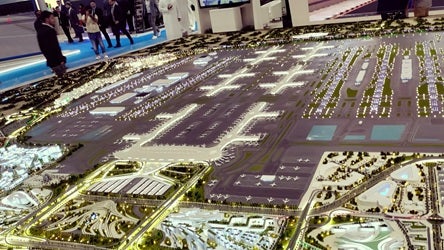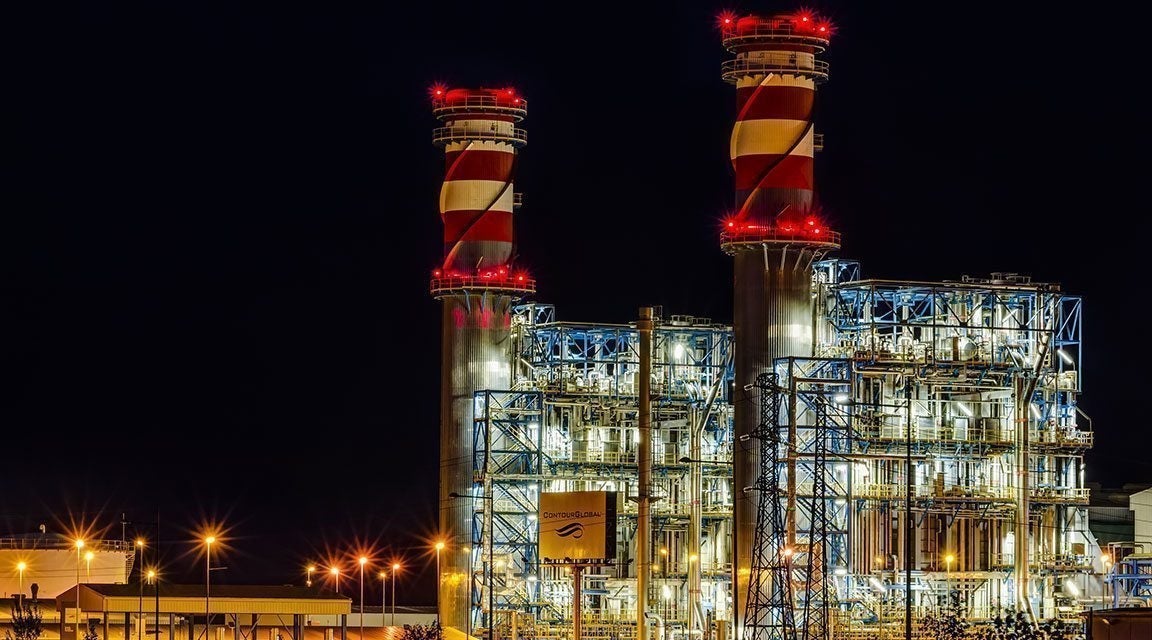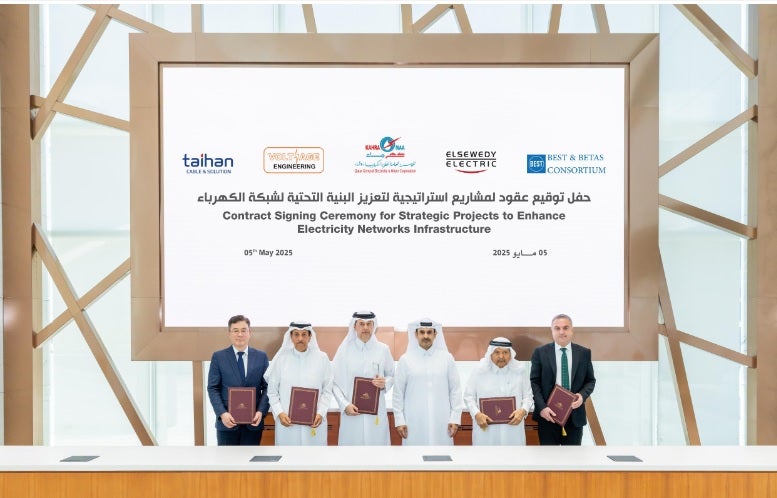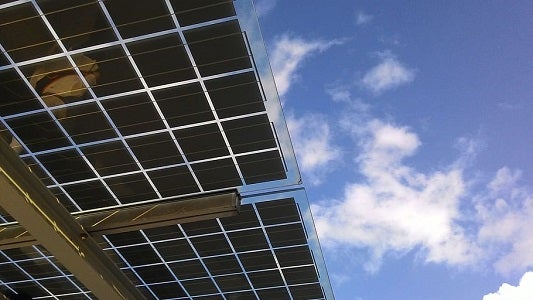Abu Dhabi to procure 30GW of capacity by 2031
23 February 2023
Abu Dhabi may need to procure over 16GW of thermal power capacity and around 14GW of solar photovoltaic (PV) capacity by 2031 to meet rising demand as well as clean energy goals.
Emirates Water & Electricity Company (Ewec) expects some "16.3 GW of additional thermal capacity is
required by 2036", the company's capacity procurement statement issued in September stated.
This could be fulfilled by reconfiguring thermal power generation plants whose power-purchase agreements (PPA) are due to expire between 2025 and 2030 and by procuring combined-cycle gas turbine (CCGT) and open-cycle gas turbine (OCGT) plants, with a combined total capacity of roughly 12GW by 2031.
It also expects solar PV installed capacity to reach between 16GW and 20GW by the end of 2036.
These projects are in response to the expected peak demand growth of 30 per cent between 2022 and 2029, according to Ewec.
Thermal replacement and expansion
Capacity requirement in the intervening period between 2025 and 2031 calls for additional thermal capacity of around 6.3GW due to some 7GW of expiring capacity, the state offtaker said.
It added that by 2030, the recommended optimal new solar PV capacity is around 4.5GW- 6GW, including the two committed projects at Sweihan PV and Al-Dhafra.T
Ewec expects that the emirate's total solar PV capacity will reach 7.2-8.5GW by the end of the decade.
Under the latest Ewec plan, it may enter into extension negotiations with the developers of Sweihan 1, Taweelah A1, Taweelah B2 and 3 and Fujairah F2 to meet increased thermal power generation capacity, expanding these plants' capacities by up to 6.3GW by 2031.
The remaining requirements will be met through five new CCGT or OCGT plants.
The first of these new gas-fired independent power producer (IPP) projects is located in Sweihan, as MEED reported.
Ewec expects the plant to reach commercial operation by 2027.
Another IPP with the same capacity, Taweelah C IPP, is planned with a target commercial operation date of 2029.
Three other new CCGT plants are under consideration until 2031. They will be located in ICAD, Mirfa and Mina Sagr.
Ewec last awarded a gas-fired IPP contract in February 2020. The 2,400MW Fujairah F3 CCGT plant is expected to complete this year.
Japan-based Marubeni Corporation will develop and operate the $1.1bn F3 project.
Marubeni submitted the second-lowest bid of 16.812 AED fils a kilowatt hour (fils/kWh) for the combined-cycle gas turbine scheme in 2019.
Another team, led by France’s Engie, submitted the lowest bid of 16.7901 fils/kWh.
France’s EDF and Japan’s Jera submitted a tariff price of 17.109 fils/kWh for the F3 project.
Exclusive from Meed
-

-

-

-
 Firms bag $850m Qatar substation contracts
Firms bag $850m Qatar substation contracts8 May 2025
-

All of this is only 1% of what MEED.com has to offer
Subscribe now and unlock all the 153,671 articles on MEED.com
- All the latest news, data, and market intelligence across MENA at your fingerprints
- First-hand updates and inside information on projects, clients and competitors that matter to you
- 20 years' archive of information, data, and news for you to access at your convenience
- Strategize to succeed and minimise risks with timely analysis of current and future market trends

Related Articles
-
 Dubai awards $272m Al-Maktoum airport runway deal
Dubai awards $272m Al-Maktoum airport runway deal9 May 2025

Dubai Aviation Engineering Projects (DAEP) has awarded a AED1bn ($272m) deal to local firm Binladin Contracting Group to construct the second runway as part of the expansion of Dubai’s Al-Maktoum International airport.
MEED understands that the contract was finalised in Q1 of this year, and the construction works have started.
The airport, which will cover an area of 70 square kilometres south of Dubai, will have five parallel runways, five terminal buildings and 400 aircraft gates.
It will be five times the size of the existing Dubai International airport and have the world’s largest passenger handling capacity of 260 million passengers a year. For cargo, it will have the capacity to handle 12 million tonnes a year.
The construction works on the first phase of the project are expected to be completed by 2032.
Dubai approved the updated designs and timelines for its largest construction project in April last year.
The government of Dubai said that the plan is for all operations from Dubai International airport to be transferred to Al-Maktoum International airport within 10 years.
The government statement added that the project will create housing demand for 1 million people around the airport.
In September last year, MEED exclusively reported that a team comprising Austria’s Coop Himmelb(l)au and Lebanon’s Dar Al-Handasah had been confirmed as the lead master planning and design consultants on the expansion of Dubai’s Al-Maktoum International airport.
Project history
The expansion of Al-Maktoum International airport is a long-standing project. Also known as Dubai World Central (DWC), it was officially launched in 2014 with a different design from the one approved in April 2024. Back then, it involved building the biggest airport in the world by 2050, with the capacity to handle 255 million passengers a year.
An initial phase, due to be completed in 2030, involved increasing the airport’s capacity to 130 million passengers a year. The development was to cover an area of 56 square kilometres.
Progress on the project slipped as the region grappled with the impact of lower oil prices and Dubai focused on developing the Expo 2020 site. Tendering for work on the project then stalled with the onset of the Covid-19 pandemic in early 2020.
MEED’s May 2025 report on the UAE includes:
> COMMENT: UAE is poised to weather the storm
> GOVERNMENT & ECONOMY: UAE looks to economic longevity
> BANKING: UAE banks dig in for new era
> UPSTREAM: Adnoc in cruise control with oil and gas targets
> DOWNSTREAM: Abu Dhabi chemicals sector sees relentless growth
> POWER: AI accelerates UAE power generation projects sector
> CONSTRUCTION: Dubai construction continues to lead region
> TRANSPORT: UAE accelerates its $60bn transport push
> DATABANK: UAE growth prospects head northhttps://image.digitalinsightresearch.in/uploads/NewsArticle/13847301/main.jpg -
 Siemens Energy signs preliminary 14GW Iraq pact
Siemens Energy signs preliminary 14GW Iraq pact9 May 2025
Register for MEED’s 14-day trial access
Germany’s Siemens Energy and Iraq’s Electricity Ministry have signed a preliminary agreement to add 14GW of electricity generation capacity to Iraq’s grid.
The firms also signed two long-term service contracts for the Dibis and Al-Mussaib gas-fired power plants.
The contract for the Dibis power plant covers two generating units with a combined capacity of 340MW.
The five-year maintenance contract for the Al-Mussaib power station includes rehabilitating units with a capacity of 750MW and an additional 150MW, along with support for safe operations and performance optimisation.
The announcement was made following a meeting between Siemens Energy CEO Christian Bruch and Iraqi Prime Minister Mohammed Al-Sudani, local media reported.
The deals were signed a few weeks after US-headquartered GE Vernova signed a memorandum of understanding (MoU) with the Iraqi government to establish 24GW of combined-cycle gas turbine (CCGT) power plants in the country.
In late April, Iraq and Siemens Energy also announced breaking ground on a project to build a new CCGT power generation plant in Nasiriyah in Iraq’s southern Dhi Qar governorate.
The project is part of a $1.68bn development package that Al-Sudani recently launched.
In addition to the CCGT plant, the other projects include the Nasiriyah Integrated Medical City, a 700-bed hospital complex and infrastructure works in the Suq Al-Shuyukh district.
https://image.digitalinsightresearch.in/uploads/NewsArticle/13847219/main.jpg -
 Abu Dhabi hopes bigger is better with Disney theme park
Abu Dhabi hopes bigger is better with Disney theme park8 May 2025
 Commentary
Commentary
Colin Foreman
EditorEver since Aldar Properties first launched the Yas Island project with its Yas Marina Circuit for the Abu Dhabi Grand Prix in 2006, Abu Dhabi has been steadily adding theme parks to the island’s roster of attractions. First, there was the Ferrari theme park, then came a water park, a Warner Bros theme park and, most recently, SeaWorld.
The theory with theme park development is bigger is better.
A destination needs a series of parks to create a critical mass to attract visitors who can stay and enjoy multiple parks in one visit. The example always cited is Florida, which is home to many of the world’s largest theme parks, including Disney World.
The theory gained particular traction in the region when Dubai Parks and Resorts opened. The company, which was public until it was acquired by Meraas in 2021, reported significant losses as it struggled to attract enough visitors.
Although it opened with Legoland, Legoland Waterpark, Motiongate and Bollywood theme parks, insiders said that the problem with the development was that it did not have enough attractions to turn it into a successful theme park destination.
The financial performance of theme parks on Yas Island has not been publicly disclosed. While it is accepted that they have been more successful than their counterparts in Dubai, some say that the island still does not have the critical mass required to establish itself as a global destination for theme park visitors.

Miral has developed a series of theme parks and other entertainment-related attractions on Yas Island
Enter Disney
Disney changes that. It is the largest brand in the theme park space and will be a major attraction, but with limited information released on the project so far, it is difficult to fully gauge how significant the project will be.
The official release said that the project will be developed and operated by Abu Dhabi developer Miral, adding that Disney’s in-house design and engineering unit, Walt Disney Imagineering, will lead creative design and operational oversight to provide a world-class experience. It did not give any details on the ownership of the project.
In Hong Kong, for example, a company, Hong Kong International Theme Parks, was established as a joint venture, with the Government of Hong Kong holding 57% and The Walt Disney Company holding 43%.
In Japan, the structure is different. The Tokyo Disney Resort is owned and operated by Oriental Land, and the company pays licences and royalties to The Walt Disney Company.
In interviews following the launch announcement, Miral CEO Mohamed Abdalla Al-Zaabi confirmed the arrangement will be like Tokyo.
Waterfront location
The official release for the Abu Dhabi launch also said that the project is on Yas Island, which only has limited areas of land to develop. The release also said that the land is waterfront, and imagery in the launch video shows the Abu Dhabi skyline in the background, suggesting the land is on the northern waterfront of Yas Island.
There is a substantial tract of undeveloped land on the north shore of the island, which measures about 2 square kilometres (sq km). This is larger than the site that Hong Kong Disneyland occupies, and much smaller than Disney World in Florida, which spans an area of 111 sq km – nearly five times the size of the whole of Yas Island and nearly double the size of Abu Dhabi Island.
The hope is that Yas Island will become a leading global theme park destination and attract large numbers of visitors wanting a holiday with multiple theme park visits
Exclusivity clause
Another area of interest will be whether Abu Dhabi has an exclusivity agreement with Disney for the region. No exclusivity was mentioned at the launch, but in Hong Kong, the issue became contentious when Disney announced plans to build a park shortly after Disneyland Hong Kong opened. Local politicians criticised the Hong Kong government for not including an exclusivity clause in its deal with Disney.
Tourism gateway
Like Hong Kong, Abu Dhabi is a smaller economy sitting next to a larger regional player. With Saudi Arabia’s ambitious Vision 2030 strategy and its existing roster of theme park developments at Qiddiya, which includes a Six Flags, a water park and a Dragon Ball Z theme park, developers in Riyadh would likely be keen to have a Disney theme park, too.
For now, with Disney on board in Abu Dhabi, the hope is that Yas Island will become a leading global theme park destination and attract large numbers of visitors wanting a holiday with multiple theme park visits.
The potential is certainly there. During the project launch, Disney highlighted that the UAE is located within a four-hour flight of one-third of the world’s population, making it a significant gateway for tourism. It is also home to the largest global airline hub in the world, with 120 million passengers travelling through Abu Dhabi and Dubai each year.
If that potential is realised, then the bigger is better theory will be proved right. If the park’s performance disappoints, then it will suggest the region is not such a great destination for theme parks after all.
https://image.digitalinsightresearch.in/uploads/NewsArticle/13840555/main.gif -
 Firms bag $850m Qatar substation contracts
Firms bag $850m Qatar substation contracts8 May 2025
Four local and international firms have won contracts for the construction of seven high-voltage substations in Qatar.
State-backed Qatar General Electricity & Water Corporation (Kahramaa) signed the contracts, which have a total combined value of approximately QR3.1bn ($850m), with the following firms:
- Elsewedy Cables Qatar Company (local/Egypt)
- Voltage Engineering (local)
- Best/Betas Consortium (Turkey)
- Taihan Cable & Solution (South Korea)
Kahramaa said the projects aim to “meet electrical network demand in light of the country's fast-growing …urban development”.
The contracts include the provision and installation of underground cables and overhead lines extending around 212 kilometres to connect these substations.
Qatari companies won the largest share, equivalent to 58.4% or QR1.8bn, of the total contract value.
This reflects “our great confidence in the capabilities of the local private sector and its pivotal role in achieving our development vision and achieving Qatar National Vision 2030”, said Kahramaa president Abdulla Bin Ali Al-Theyab.
Qatar Minister of State for Energy Affairs, Saad Sherida Al-Kaabi, and senior executives from Kahramaa and the contracting firms signed the deals at a ceremony held in Doha.
Al-Kaabi said the projects will help “ensure our networks' continued and sustainable ability to accommodate the unprecedented growth of the power sector and meet the increasing electricity demand”.
Kahramaa said the contractors will undertake the construction of electrical substations and the connection of cables and overhead lines, as well as the development of some existing substations to increase their capacity.
Qatar has been ramping up its power generation capacity in recent years.
Qatar's Emir, Sheikh Tamim Bin Hamad Al-Thani, inaugurated the Ras Laffan and Mesaieed solar photovoltaic (PV) power plants on 28 April.
The two plants have a combined capacity of 875MW and will more than double Qatar’s solar energy production to 1,675MW.
In February, Qatar Electricity & Water Company (QEWC) and Kahramaa signed a power-purchase agreement for a 511MW peak electricity generation plant at Ras Abu Fontas, which will have a total cost of approximately QR1.6bn. The peak power plant is scheduled to become operational by January 2027.
A consortium led by South Korea's Doosan Enerbility, and that includes Beijing-headquartered PowerChina, will undertake the Ras Abu Fontas peak power plant's engineering, procurement and construction contract, with Germany's Siemens Energy supplying the plant's gas turbines.
Photo credit: Kahramaa
https://image.digitalinsightresearch.in/uploads/NewsArticle/13838850/main.jpg -
 OQ to take interest in Oman renewable projects
OQ to take interest in Oman renewable projects8 May 2025
OQ Alternative Energy (OQAE), part of Oman’s state-backed energy group OQ, will be taking shares in Oman’s renewable energy independent power projects (IPP), starting with the Ibri 3 solar scheme.
“The direction seems to be for OQ Alternative Energy to own up to 25% shares in the upcoming solar and wind IPP projects in the sultanate,” says a source familiar with the plans.
Before this development, private developers and investors owned the total shares in such projects, similar to the existing structure in Saudi Arabia.
With this policy change, Oman will now be more closely aligned with the existing project structure in the UAE, where either Abu Dhabi National Energy Company (Taqa), Abu Dhabi Future Energy Company (Masdar) or the state utility, Dubai Electricity & Water Authority (Dewa), owns stakes in these projects.
However, OQAE’s planned 25% ownership share will be slightly lower than the typical 40% to 60% shares that Taqa, Masdar or Dewa owns in the UAE’s renewable energy IPP projects.
Currently, OQAE owns a 51% share in three renewable energy projects being developed in partnership with France’s TotalEnergies for the state-backed firm, Petroleum Development Oman (PDO).
The Riyah-1 and Riyah-2 wind power plants will be located in the Amin and West Nimr fields in southern Oman, while the North Solar project will be situated in northern Oman.
Each plant will have a capacity of 100MW, Total Energies announced in December.
PDO will purchase the electricity from the plants through long-term power-purchase agreements with the developer team, whose 49% shares are owned by TotalEnergies.
OQAE is also part of Hyport Coordination Company, a consortium comprising Belgium’s Deme Concessions and BP Oman. The consortium plans to develop a green hydrogen project in Duqm that can produce more than 50 tonnes a year of green hydrogen in its first phase by 2029.
https://image.digitalinsightresearch.in/uploads/NewsArticle/13838800/main.jpg

